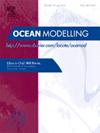Current effects on wind generated waves near an Ocean Eddy Dipole
IF 2.9
3区 地球科学
Q2 METEOROLOGY & ATMOSPHERIC SCIENCES
引用次数: 0
Abstract
Ocean eddy dipoles are among the most common mesoscale features and may be ubiquitous across the global oceans. However, wave–current interactions in their proximity have not been extensively studied. Here we examine the impact of surface currents on the wave field near an ocean eddy dipole. Using the WW3 wave model, we conducted idealized numerical simulations to assess the influence of different configurations on the spatial variability of Significant Wave Height (). Additionally, a two-month hindcast of a strong dipole event in the Southwestern Atlantic Ocean was performed using three distinct surface current products: SSalto/Duacs, HYCOM NCODA and GlobCurrent. Among these, HYCOM, which incorporates ageostrophic effects, provided a more detailed representation of oceanic energy compared to GlobCurrent and SSalto/Duacs, which primarily reflect geostrophic components. The hindcast assessment employed denoised altimeter-derived data, with a spatial resolution of approximately 6 km. The greatest increase in wave energy occurs in the region between the peak values of positive and negative vorticity, where the opposing surface currents reach their maximum intensity. Therefore, dipoles act as converging lenses for surface waves, channeling their refraction toward the central jet. Despite its poorer spatial and temporal resolutions, SSalto-Duacs surface current data provides more reliable fields, in the study region where geostrophic dynamics are expected to be significant or even dominant. Both Absolute Dynamic Topography derived surface current inputs produce comparable effects on the wave field, with the inclusion of the Ekman component yielding no substantial enhancement. HYCOM captures a broader range of dynamical processes, essential for accurately representing the total energy, though discrepancies with SSalto/Duacs data may arise from assimilation inaccuracies and model limitations. While gridded altimetry may underestimate total current components during dipole events, it offers precise insights into their positioning and evolution, useful for specific event analysis and near real-time forecasting for marine safety.
洋流对海洋涡旋偶极子附近风产生的波浪的影响
海洋涡旋偶极子是最常见的中尺度特征之一,可能在全球海洋中无处不在。然而,在它们附近的波流相互作用尚未得到广泛的研究。在这里,我们研究了海洋涡旋偶极子附近的表面流对波场的影响。利用第三次世界大战波浪模式,进行了理想化数值模拟,评估了不同配置对有效波高(Hs)空间变异的影响。此外,使用SSalto/Duacs、HYCOM NCODA和GlobCurrent三种不同的表面流产品,对西南大西洋的强偶极子事件进行了两个月的后预报。其中,与主要反映地转分量的GlobCurrent和SSalto/Duacs相比,HYCOM结合了地转效应,提供了更详细的海洋能量表征。后播评估采用降噪高度计衍生的Hs数据,空间分辨率约为6公里。波浪能量的最大增加发生在正涡度和负涡度峰值之间的区域,在那里,相反的表面流达到最大强度。因此,偶极子充当表面波的汇聚透镜,引导它们的折射向中央喷流。尽管SSalto-Duacs地表流数据的空间和时间分辨率较差,但在地转动力学预计会很重要甚至占主导地位的研究区域,SSalto-Duacs地表流数据提供了更可靠的Hs场。两种绝对动态地形导出的表面电流输入对波场产生相当的影响,包括Ekman分量没有产生实质性的增强。HYCOM捕获了更广泛的动力学过程,这对于准确表示总能量至关重要,尽管与SSalto/Duacs数据的差异可能源于同化不准确和模型限制。虽然网格高程测量可能低估了偶极子事件期间的总电流分量,但它提供了对其定位和演变的精确见解,对特定事件分析和海洋安全的近实时预测非常有用。
本文章由计算机程序翻译,如有差异,请以英文原文为准。
求助全文
约1分钟内获得全文
求助全文
来源期刊

Ocean Modelling
地学-海洋学
CiteScore
5.50
自引率
9.40%
发文量
86
审稿时长
19.6 weeks
期刊介绍:
The main objective of Ocean Modelling is to provide rapid communication between those interested in ocean modelling, whether through direct observation, or through analytical, numerical or laboratory models, and including interactions between physical and biogeochemical or biological phenomena. Because of the intimate links between ocean and atmosphere, involvement of scientists interested in influences of either medium on the other is welcome. The journal has a wide scope and includes ocean-atmosphere interaction in various forms as well as pure ocean results. In addition to primary peer-reviewed papers, the journal provides review papers, preliminary communications, and discussions.
 求助内容:
求助内容: 应助结果提醒方式:
应助结果提醒方式:


